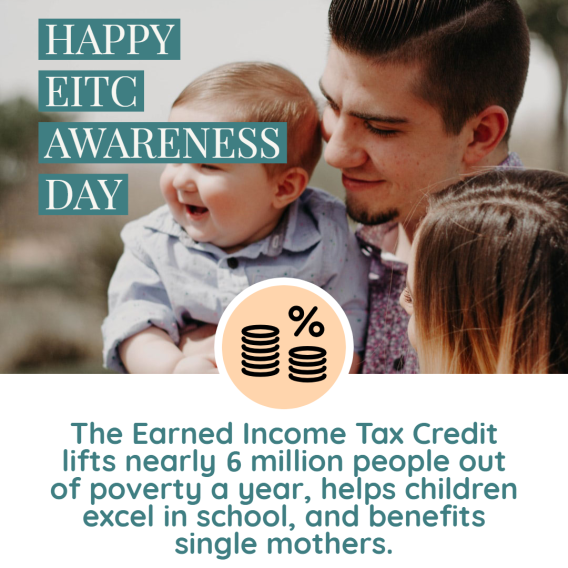The 2021 Child Tax Credit (CTC) expansion provides a historic opportunity to reduce child poverty in the United States. It will lift 4.1 million children above the poverty line — cutting the number of children in poverty by more than 40 percent. It will also lift about 1.1 million children out of deep poverty. The expanded CTC includes five key features:
- Increased credit amount: The credit is worth $3,000 per child age 6-17 and $3,600 for children under the age of 6
- Expanded age limit: Children age 17 and under can qualify for the credit
- Fully refundable: Families with low or no recent earnings will receive the full credit amount
- Advance payments: Monthly advance payments will be delivered between July to December 2021
- Lower phase-out rate: The CTC amount starts to decrease at $75,000 for single filers ($150,000 for married couples and $112,500 for heads of households)
While most children in the US are in families that will get advance CTC payments automatically, some children are in families that are considered non-filers and will need help signing up for them.
What do we know about CTC non-filers?
Many groups want to learn more about who non-filers are and where they are located to reach them. Non-filers eligible for the CTC may include people who:
- Have very low to no income: Many earn less than $2,500
- Have limited internet and technology access
- Participate in SNAP or TANF
- Have a disability
- Are people of color: Black and Latino children have disproportionately benefitted less from the CTC
- Are in immigrant households: People with Individual Taxpayer Identification Numbers (ITINs) can get the CTC if their child has a valid social security number
- Receive Social Security or Supplemental Security Income: While these adults got stimulus payments automatically for themselves, if they have children who don’t receive these benefits, they won’t get the CTC payments automatically
Reaching this population will require additional effort. Last year’s push to reach people who aren’t required to file taxes and are eligible for stimulus checks brought a lot of non-filers into the tax system. Many of the CTC non-filers are likely to not have gotten stimulus checks or may not have received the full amounts for their dependents.
The CTC outreach opportunity
Your efforts to help people get advance CTC payments are essential. Many people will need help to understand their eligibility and to use GetCTC.org. Unfortunately, most typical places for help are under-resourced and don’t have the capacity to provide the support needed. Additionally, the IRS has limited capacity to answer phone calls.
People can continue to sign up for advance CTC payments. While the IRS will begin delivering payments July 15, if someone signs up later, after the IRS processes their information, they will still receive half of their CTC in 2021. People who miss the advance payment window completely can get the full CTC by filing a 2021 tax return in 2022. So, it is never too late to conduct CTC outreach activities.
There are two primary goals for CTC outreach:
- Raise awareness: inform people about the availability of advance CTC payments, who needs to take action, and how to manage them through the upcoming CTC update portal.
- Help non-filers get payments: answer questions about eligibility and help people use GetCTC.org to sign up for payments.
The information on this page can help you identify how to participate in CTC outreach efforts. The spectrum of opportunities presented accounts for different capacity levels and includes ideas to contribute to both outreach goals, with an emphasis on supporting non-filers since this is where there is the greatest need.
Developing your outreach plan
There are two key steps when building an outreach plan:
- Identify local resources. You don’t need to be a tax expert to do CTC outreach. Find out where you can connect people to additional support and what outreach materials you can use that can expand your capacity.
- Figure out your role and what you can offer. Do you and your organization have the capacity to assist, refer, or notify?
1. What local resources are available?
Finding organizations offering support to help people complete the form on GetCTC.org may be a challenge. Start by contacting your local United Way and Community Action Agency. You can also call your area 211.
In addition to getting support with signing up for CTC payments, some people will need help establishing a bank account for direct deposit or finding free check cashing. Contact financial institutions to learn local options to support people to receive their payments.
Paper checks:
- Are there banks or credit unions that offer free check cashing?
- What are their hours of operation?
Direct deposit:
- Are there local financial institutions that can help people open an account remotely? Use this list as a starting place to identify accounts that meet national standards for affordability and coalitions that work to connect people to bank accounts.
As you learn about any existing outreach efforts underway, ask about what outreach materials are being used. The Get It Back Campaign has a suite of resources for national use. Many are customizable to include local information.
If local materials exist, use those instead or in conjunction. This will help with consistency and allow you to share the most local and relevant sources for help.
2. What is your outreach role?
Once you identify what local resources are available to help non-filers, it’s time to determine your outreach role. The three roles are listed from most involved to least involved.
Assist – As an assistor, you will help connect non-filers to CTC advance payments. There are several ways to serve as an assistor.
- Help people use GetCTC.org. You do not need to be a tax preparer to use GetCTC.org. Read this guide by Code for America to learn how to navigate GetCTC.org and determine the right next steps for families. (Click here for all of Code for America’s navigator resources).
- Provide technology for people to use GetCTC.org. Some people who are comfortable using technology, but do not have internet access may just need access to a secure computer or mobile device.
- Partner with local groups to hold CTC sign-up days. The IRS is organizing sign up events in 12 cities in June and July.
- Answer questions about claiming the CTC and using GetCTC.org. For example, people need to know that they can get CTC payments even if they don’t have a permanent address and that getting the CTC doesn’t impact public benefits. See our expanded CTC FAQs.
- Offer to let people use your organization’s mailing address when they use GetCTC.org. A permanent home address is not required, but address information cannot be left blank on the form. Many organizations provided their addresses last year (including PO boxes) to help connect more people who are unhoused to stimulus payments. If you’re unable to, contact service providers to see who can.
- Help people assess whether it is more beneficial to use GetCTC.org or to file a full tax return. People who have some earned income may want to file a tax return to claim other tax credits like the Earned Income Tax Credit.
- Help people create bank accounts or get reloadable debit cards for direct deposit. Direct deposit is the fastest and safest way to receive payments. People who don’t have or don’t want bank accounts can still receive direct deposit using reloadable debit cards or payment apps like Cash App, PayPal, or Venmo.
- Help people create an email address. People can use a phone number or email address to use GetCTC.org. If people don’t have a phone, they will need an email address. Help people set up an email account using a free service like Gmail or Yahoo.
- Connect immigrants without SSNs to help with ITINs. Some groups can help one apply for or renew an ITIN. Since ITIN applications must be submitted by mail, it can take months for the IRS to process the paperwork. Provide reassurance to people who have already submitted documents and are concerned whether they need to do something else.
Refer – As a referrer, you will directly connect people to support to use GetCTC.org and help them set up an appointment, if needed. Referrers may also make calls for people to confirm operating hours and verify what people need to bring with them. A referrer may use flyers, appointment card reminders, or checklists.
Notify – As a notifier, you will share information about the availability of CTC advance payments, who does and doesn’t need to take action, and direct people to sources for more information. A notifier may share information through emails, texts, social media, flyers, or mailers.
Additional ways you can contribute to CTC outreach efforts:
- Help get CTC resources translated into languages spoken in your community. The Get it Back Campaign’s toolkit for immigrant outreach is translated into Arabic, Chinese, French, Spanish, and Vietnamese.
- Help people understand IRS notices. The IRS started sending letters to people who filed a 2019 or 2020 tax return in early June. The IRS will send as many as 4 additional letters which people may need help understanding why they are getting it and whether or not they need to do anything.
- Answer questions about managing payments and assist people to do so on the Child Tax Credit Update Portal (CTC UP). People can opt out of payments and make changes to their bank account and mailing information. Eventually they will be able to update the number of children they claim, marital status, and income. The Get it Back Campaign has a guide and training for you to assist others with this.
- Generate positive media coverage on the CTC advance payments. Once people start getting payments in July and August, you can help collect stories and conduct interviews to highlight how the money is helping families.
Let us know what you will do or reach out if you need help developing your plans.







